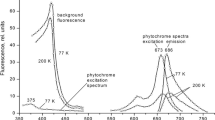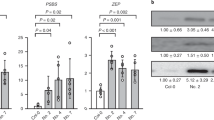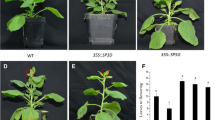Abstract
Avena phytochrome A (phyA) overexpressed in tobacco (Nicotiana tabacum L.) and tomato (Lycopersicon sculentum Mill) was functionally characterised by comparing wild-type (WT) and transgenic seedlings. Different proportions of phytochrome in its far-red-absorbing form (Pfr/P) were provided by end-of-day (EOD) light pulses. Stem-length responses occurred largely in the range of low Pfr/P (3–61%) for WT seedlings and in the range of high Pfr/P (61–87%) for transgenic seedlings. A similar shift was observed when the photoperiod was interrupted by short light pulses providing different Pfr/P ratios and followed by 1 h dark incubation. In other experiments, Avena phyA was allowed to re-accumulate in darkness and subsequently phototransformed to Pfr but no extra inhibition of stem extension growth was observed. In transgenic tomato seedlings the response to EOD far-red light was faster and the response to a far-red light pulse delayed into darkness was larger than in the WT. Avena phyA Pfr remaining at the end of the photoperiod appears intrinsically unable to sustain growth inhibition in subsequent darkness. Avena phyA modifies the sensitivity and the kinetics of EOD responses mediated by native phytochrome.
Similar content being viewed by others
Abbreviations
- EOD:
-
end-of-day
- FR:
-
far-red light
- Pfr/P:
-
pro-portion of phytochrome in its FR-absorbing form
- phyA:
-
phyto-chrome A
- phyB:
-
phytochrome B
- R:
-
red light
- R∶FR:
-
R to FR ratio
- WT:
-
wild type
References
Ballaré, C.L., Sánchez, R.A., Scopel, A.L., Casal, J.J., Ghersa, C.M. (1987) Early detection of neighbour plants by phytochrome perception of spectral changes in reflected sunlight. Plant Cell Environ. 10, 551–557
Boylan, M.T., Quail, P.H. (1989) Oat phytochrome is biologically active in transgenic tomatoes. Plant Cell 1, 765–773
Carr-Smith, H.D., Johnson, C.B., Plumpton, C., Butcher, G.W., Thomas, B. (1994) The kinetics of type 1 phytochrome in green, light-grown wheat (Triticum aestivum L.) Planta 194, 136–142
Casal, J.J. (1995) Coupling of phytochrome B to the control of hypocotyl growth in Arabidopsis. Planta 196, 23–29
Casal, J.J., Kendrick, R.E. (1993) Impaired phytochrome-mediated shade avoidance responses in the aurea mutant of tomato. Plant Cell Environ. 16, 703–710
Casal, J.J., Sánchez, R.A. (1994) Overexpression of oat phytochrome A gene differentially affects stem growth responses to red/far-red ratio signals characteristic of sparse or dense canopies. Plant Cell Environ. 17, 409–417
Casal, J.J., Sánchez, R.A., Di Benedetto, A.H., De Miguel, L.C. (1991) Light promotion of seed germination in Datura ferox is mediated by a highly stable pool of phytochrome. Photochem. Photobiol. 53, 249–254
Casal, J.J., Sánchez, R.A., Gibson, D. (1990) The significance of changes in the red/far-red ratio associated either to neighbour plants or to twilight for tillering in Lolium multiflorum Lam. New Phytol. 116, 565–572
Casal, J.J., Sánchez, R.A., Vierstra, R.D. (1994) Avena phytochrome A overexpressed in transgenic tobacco seedlings differentially affects red/far-red reversible and very-low-fluence responses (cotyledon unfolding) during de-etiolation. Planta 192, 306–309
Casal, J.J., Smith, H. (1989) The “end-of-day” phytochrome control of internode elongation in mustard. Kinetics, interaction with the previous fluence rate and ecological implications. Plant Cell Environ. 12, 511–520
Cherry, J.R., Hershey, H.P., Vierstra, R.D. (1991) Characterization of tobacco expressing functional oat phytochrome. Domains responsible for the rapid degradation of Pfr are conserved between monocots and dicots. Plant Physiol. 96, 775–785
Clack, T., Mathews, S., Sharrock, R.A. (1994) The phytochrome apoprotein family in Arabidopsis is encoded by five genes: the sequence and expression of PHYD and PHYE. Plant Mol. Biol. 25, 413–427
Dehesh, K., Franci, C., Parks, B.M., Seeley, K.A., Short, T.W., Tepperman, J.M., Quail, P.H. (1993) Arabidopsis HY8 locus encodes phytochrome A. Plant Cell 5, 1081–1088
Dehesh, K., Tepperman, J., Christensen, A.H., Quail, P.H. (1991) phyB is evolutionary conserved and constitutively expressed in rice seedling shoots. Mol. Gen. Genet. 225, 305–313
Downs, R.J., Hendricks, S.B., Borthwick, H.A. (1957) Photoreversible control of elongation of pinto beans and other plants under normal conditions of growth. Bot. Gaz. 118, 199–208
Kay, S.A., Keith, B., Deak, M., Furuya, M., Chua, N.-H. (1989) Rice phytochrome is biologically active in transgenic tobacco. Plant Cell 1, 775–782
Keller, J.M., Shaklin, J., Vierstra, R.D., Hershey, H.P. (1989) Expression of a functional monocotyledonous phytochrome in transgenic tobacco. EMBO J. 8, 1005–1012
López-Juez, E., Nagatani, A., Tomizawa, K-I., Deak, M., Kern, R., Kendrick, R.E., Furuya, M. (1992) The cucumber long hypocotyl mutant lacks a light-stable PHYB-like phytochrome. Plant Cell 4, 241–251
McCormac, A.C., Cherry, J.R., Hershey, H.P., Vierstra, R.D., Smith, H. (1991) Photoresponses of transgenic tobacco plants expressing an oat phytochrome gene. Planta 185, 126–170
McCormac, A., Whitelam, G.C., Smith, H. (1992) Light-grown plants of transgenic tobacco expressing an introduced oat phytochrome A gene under the control of a constitutive viral promoter exhibit persistent growth inhibition by far-red light. Planta 188, 173–181
McCormac, A.C., Wagner, D., Boylan, M.T., Quail, P.H., Smith, H., Whitelam, G.C. (1993a) Photoresponses of transgenic Arabidopsis seedlings expressing introduced phytochrome B-encoding cDNAs: evidence that phytochrome A and phytochrome B have distinct photoregulatory functions. Plant J. 4, 19–27
McCormac, A., Whitelam, G.C., Smith, H. (1993b) Photoregulation of germination in seeds of transgenic lines of tobacco and Arabidopsis which express an introduced cDNA encoding phytochrome A or phytochrome B. Planta 191, 386–393
Nagatani, A., Chory, J., Furuya, M. (1991a) Phytochrome B is not detectable in the hy3 mutant of Arabidopsis, which is deficient in responding to end-of-day far-red light treatments. Plant Cell Physiol. 32, 1119–1122
Nagatani, A., Kay, S.A., Deak, M., Chua, N-H., Furuya, M. (1991b) Rice type I phytochrome regulates hypocotyl elongation in transgenic tobacco seedlings. Proc. Natl. Acad. Sci. USA 88, 5207–5211
Nagatani, A., Reed, J. W., Chory, J. (1993) Isolation and initial characterization of Arabidopsis mutants that are deficient in phytochrome A. Plant Physiol. 102, 269–277
Parks, B., Quail, P.H. (1993) hy8, a new class of Arabidopsis long hypocotyl mutants deficient in functional phytochrome A. Plant Cell 5, 39–48
Schäfer, E., Ebert, C., Schweitzer, M. (1984) Control of hypocotyl growth in mustard seedlings after light-dark transitions. Photochem. Photobiol. 39, 95–100
Sharma, R., López-Juez, E., Nagatani, A., Furuya, M. (1993) Identification of photo-active phytochrome A in etiolated seedlings and photo-inactive phytochrome B in green leaves of the aurea mutant of tomato. Plant J. 4, 1035–1042
Sharrock, R.A., Quail, P. (1989) Novel phytochrome sequences in Arabidopsis thaliana: structure, evolution and differential expression of a plant regulatory photoreceptor family. Genes Devel. 3, 1745–1757
Smith, H. (1982) Light quality, photoperception and plant strategy. Annu. Rev. Plant Physiol. 33, 481–518
Smith, H., Whitelam, G.C., McCormac, A.C. (1991). Do members of the phytochrome family have different roles? Physiological evidence from wild-type, mutant and transgenic plants, In: Phytochrome properties and biological activity, pp. 217–226, Thomas, B., Johnson, C.B., eds, Springer Verlag, Heidelberg, Germany.
Somers, D.E., Sharrock, R.A., Tepperman, J.M., Quail, P.H. (1991) The hy3 long hypocotyl mutant of Arabidopsis is deficient in phytochrome B. Plant Cell 3, 1263–1274
Wang, Y.-C., Stewart, S.J., Cordonier, M.-M., Pratt, L.H. (1991) Avena sativa L. contains three phytochromes, only one of which is abundant in etiolated tissue. Planta 184, 96–104
Wildermann, A., Drumm, H., Schäfer, E., Mohr, H. (1978) Control by light of hypocotyl growth in de-etiolated mustard seedlings. II Sensitivity for newly-formed phytochrome after a light to dark transition. Planta 141, 217–223
Author information
Authors and Affiliations
Additional information
We thank Dr Brian Thomas for providing the antibodies used in this work, and Federico Guerendiain for his excellent technical assistance. This work was financially supported by grants UBA AG 040 and Fundacion Antorchas A-12830/1-19 (both to J.J.C.), PID-CONICET (to R.A.S. and J.J.C.), United States Department of Energy DE-FG02-88ER13968 (to R.D.V.).
Rights and permissions
About this article
Cite this article
Casal, J.J., Sánchez, R.A., Boylan, M. et al. Is the far-red-absorbing form of Avena phytochrome A that is present at the end of the day able to sustain stem-growth inhibition during the night in transgenic tobacco and tomato seedlings?. Planta 197, 225–232 (1995). https://doi.org/10.1007/BF00202641
Received:
Accepted:
Issue Date:
DOI: https://doi.org/10.1007/BF00202641




